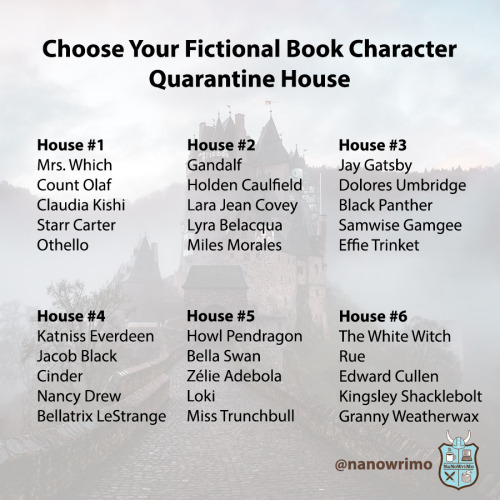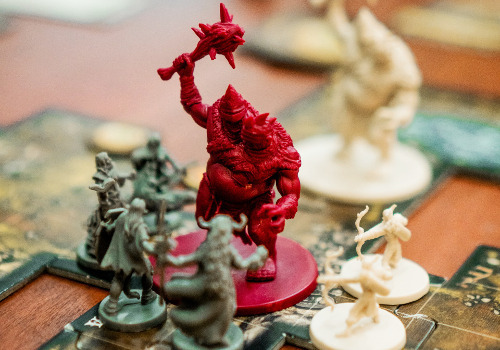Chris Baty's Blog, page 59
April 16, 2020
“Every time we sit down to write, we risk failure. So instead of...

“Every time we sit down to write, we risk failure. So instead of being afraid, you might as well embrace it. Fail with style. Fail with humor. Fail spectacularly! Without risking failure, you will never know the flavor of courage that lives inside your belly. The only thing worse than failure is that hollow guilty feeling you get from not sitting your butt in the chair and doing the work.”
—An Na is the author of four novels, including The Place Between Breaths, The Fold, Wait for Me, and A Step from Heaven, which was a National Book Award Finalist and won the ALA’s Michael L. Printz Award. Her honors include the International Reading Association Award and the Parents Choice Gold Award, and her books have been named as ALA Best Books for Young Adults and a New York Times Notable Book. She teaches at Vermont College of Fine Arts in the Writing for Children and Young Adults MFA.
Your Camp Care Package is brought to you by Camp NaNoWriMo. Sign up to receive more Camp Care Packages at nanowrimo.org!
April 15, 2020
How to Write Using Real Life Experiences

It’s sound advice: “Write what you know.” That doesn’t mean drawing from your personal experiences for writing inspiration has to feel limiting! Writer Holly-Emma Johnson is here today to share with us how to use life experiences, meditation, and creativity to expand our mind when it comes to worldbuilding and character writing:
Using real life experiences in your writing lends a realism to your work that can help readers connect with your characters and world. However, ‘writing from real life’ doesn’t mean that you can’t write fantasy or sci-fi, or that you are stuck only writing about school or your neighborhood. The best characters are ones that feel real, that you could almost reach out and touch. Part of that is getting the right character arc, but the rest? It’s using tiny details from real life.
One of the best skills you can develop as a writer is noticing. I have a natural tendency to focus on what my teachers called ‘irrelevant details in her surrounding area’. This trait blossomed into a skill as I began to practice mindfulness and contemplation. Have you ever really looked at a rose? Traced the veins with your eyes, watched as dew evaporated from the small hairs on the stem in the morning, or pondered how the green cap on the end of the flower looks like another flower? (Yeah, noticing isn’t about knowing—I have no idea what that part of a rose is actually called.)
As this skill developed, it began to naturally seep into my writing without my conscious effort. Any time I reach into my mind to describe something—a person, a setting, even creating dialogue—I find that my well of images and sounds is much fuller. Settings still aren’t my best skill, but the compliment I get most about my fiction writing is that my characters feel real. Readers really do notice the small details about the way a character looks, dresses, moves and emotes. Each character must be different, and express each emotion differently to another character. For example, we all cry when very sad, but we all cry differently.
Begin, as with any meditative exercises, with yourself. What little habits do you have that you might not have noticed? How are you sitting right now? I tend to cross my feet at my ankles, resting one of them on the leg of my wheely-chair. When I’m thinking as I write, my fidgeting changes and becomes very focused on my face—touching my face with my hands, pressing the objects into my cheeks, screwing up my mouth. Who knows why I do that, but even without much description about the way I look, you’re already building up a detailed picture of me writing this post, in your mind. One that feels realer than me simply stating I have hazel eyes and have let my roots grow out.
Next, widen your gaze, keeping it soft. You’re not looking for anything in particular, just noticing whatever is in front of you at the time. What do you notice about the people around you? My Grandma bites her thumbnail—only her thumbnail—whenever she’s nervous. It doesn’t particularly matter if you don’t remember who you saw perform this behavior. Humans have a wide variety of behaviors, but we tend to associate certain behaviors with certain types of people. It can be a great narrative or comedic ‘shorthand’ to use these. Dan Avidan once opened a Q + A by straddling a backwards facing chair and announcing ‘I’m gonna sit like a cool Dad talking to you about why you shouldn’t do drugs.’ It’s such a striking and amusing image, and sticks in the mind.
By using small details, you can build up a clear image of your character’s physicality and personality using very few words at a time, keeping your narrative flow tight and exciting, and your readers engaged.

Holly-Emma Johnson writes under two pen names. This one, for her work in writing about the psychology of creativity, and Siobhan Johnson for her work in spirituality, meditation and shadow work. Her first novel is out later this year, featuring a musician selling his soul to the Devil, because she takes writing from her real life very seriously indeed. This tells you something about her real life, but what that something is is best left unclear.
April 14, 2020
"When thinking about creating a certain mood or feeling for pivotal scenes or turning points in your..."
-
An Na is the author of four novels, including The Place Between Breaths, The Fold, Wait for Me, and A Step from Heaven, which was a National Book Award Finalist and won the ALA’s Michael L. Printz Award. Her honors include the International Reading Association Award and the Parents Choice Gold Award, and her books have been named as ALA Best Books for Young Adults and a New York Times Notable Book. She teaches at Vermont College of Fine Arts in the Writing for Children and Young Adults MFA.
What is the theme song for your story? Let Na know, and/or thank her for her #CampCarePackage!
Your Camp Care Package is brought to you by Camp NaNoWriMo. Sign up to receive more Camp Care Packages at nanowrimo.org!
April 13, 2020
Adapting Your Word Count Goals to Your Environment

For many of us, writing isn’t a problem—it’s finding time to write that can be a challenge. Thankfully today we have
Tiggy McLaughlin here to teach us how to adapt our writing pace and word count goals to match our busy lives:
“Write a novel in 1667 words a day!” NaNoWriMo proclaimed to college-me in the middle 2000s: “Write on your lunch break.” “Write on the bus.” “Take a fifteen-minute study break to write.” That sounded doable. Then there was the advice from the forums: “Pack your freezer with thirty meals so you won’t have to cook all November.” “Print this ‘Do Not Disturb’ sign for your bedroom door.” “Your friends won’t see you for a month—they’ll understand.” Huh?
I did not begin to understand these conflicting messages until I attempted NaNoWriMo for myself, and realized how much our social environments impact how we write. Even on the micro level, the level of the household, our social surroundings do a large part to shape us into people who lock themselves away to write for hours, or people who write in fifteen-minute bursts. I’m a fifteen-minute writer. Here’s how I got that way:
NaNoWriMo 2010It was my first year of graduate school. I had my own room in a house with roommates I didn’t see much, and way too much Latin, Greek, and history theory to read. I might have had the space to lock myself away, but I certainly did not have the time. Essentially living alone, I was able to wake up forty-five minutes earlier to hit my daily word count goal… most days. But, when push came to shove toward the end of the month, no one really noticed when I took a weekend and hammered out 12,000 words. The next time I won, in 2012, I was living with my partner and found it much more difficult to disappear for a weekend, so I had to prioritize those forty-five minute daily writing goals.
Camp NaNoWriMo, April 2016I wrote the last chapter of my dissertation as my Camp project, but the only time I had to write was while my eleven-month-old baby napped. Thanks to six years of NaNoWriMo and a PhD advisor who promoted daily writing habits, I was able to write most of my dissertation while baby napped. Forty-five minute writing sessions became fifteen in the early days when a “nap” might only be twenty minutes long. But those fifteen minutes had to be productive, because I now lived with an infant, and there was no writing once he woke up.
Camp NaNoWriMo, April 2020I have two kids now, one in PreK and one a potty-training two-year-old. They are both home, as is my husband, who, like me, has temporarily transitioned to teaching online. And I am busy, not only with work, but with having family around me all the time. I am not sure if I will even find fifteen minutes a day to work on my Camp project, seeing as every time I’m on my computer someone in the house wants me not to be. But I will try, even if the daily goal dwindles to five minutes.
This Camp NaNoWriMo, if you are part of a community practicing social distancing in an effort to control the spread of coronavirus, chances are you’re feeling your household environment more acutely than usual. Whether you live with roommates, a partner, your parents, your kids, extended family, a friend you’re giving a stable home to in this time of crisis, or friends who have opened their home to you, you’re all home. Hopefully you give each other space for creativity, even if all you can manage to sneak away for is fifteen minutes.

Tiggy McLaughlin is a historian of Christianity in Late Antiquity (200-600 CE), where she mostly asks questions about how ordinary people worshiped and prayed. She works part-time teaching History and Theology at Gannon University and is a full-time parent to two wild little boys. She has participated more or less consistently in NaNoWriMo for the past ten years, alternating between writing medieval historical fantasy and realistic fiction about contemporary academia. Besides writing, she also enjoys playing video games with her spouse, cooking, and, of course, reading.
Top photo by Essentialiving on Unsplash.
April 10, 2020
4 Ways Online Roleplay Can Make You a Better Writer

Roleplay goes beyond tabletops! With online roleplaying on the rise, it’s a good thing that today we have Wrimo Morgan Lane to share four ways we can use roleplay forums to help us grow as writers.
I’m going to be honest with you: I spend way more time roleplaying on the NaNo forums than I do writing my personal projects. It comes more easily to me, probably in part because I’m sharing the burden of inspiration instead of providing all the forward momentum on the project—and I mean, an alternate universe scenario billing my main character as an angsty undead monster isn’t something I have going in my book. It’s addictive and sometimes distracting. Even so, the collaborative storytelling element of roleplay can help a writer hone their craft.
1. Roleplay trains you to be flexible.In my experience, stories tend to shift away from their initial conceit during the writing process. We often struggle with this part of editing as “darling” scenes become extraneous, or a character simply refuses to behave the way we want them to. Due to the collaborative nature of roleplay, however, the story is ever evolving into a shape that no one person envisioned. Did your character’s ally accept the mega-lich’s offer of immortality while they were gearing up for a straightforward battle? The other participants’ choices will force you to routinely adjust your plans, which can make it easier to run with new ideas in your own work.
When I first constructed the main character of my book, it was to fill an unimportant role—one of my villains needed a political leader to boss around, I made him up on the spot, and that was that. It wasn’t until I decided to play around with their relationship in a forum thread featuring an enormous magical bookstore that he came into his own. In enduring bizarre magical effects, he showed me how he dealt with adversity. In interacting with the other characters, he began to find his voice. When the story ended, he came out the other side as a fussy but well-intentioned person hoping to make a change in the world, which to me was prime main character material. Ever since then I have used roleplay as a testing ground for new characters.
Writing a story with other people creates a strong sense of community. We become invested in other people’s ideas and characters as they interact with our own, and oftentimes we learn from each other’s strengths. For example, my writing style tends to be dryer, which in some circumstances doesn’t work as well for drawing a reader in. When I roleplay with someone who is better at portraying emotional scenes or describing scenery in a way that doesn’t feel like slogging through purple prose, I can analyze what about the delivery worked for me. Once I recognize techniques that make an appropriate impact, I can experiment with them in my own writing.
One of the most important things for a writer to do is, well, write. Like playing an instrument, you have to consistently practice if you want to improve your word-smithing. Roleplay provides a fun way to keep your pen sharp. It also doesn’t hurt that if you stop consistently posting in a roleplay, you’ll likely have other writers checking in and holding you accountable for vanishing. After all, it’s a shared story, and whether you’re writing with one other person or a group, your input will enrich the experience for everyone.
Now, if you’ll excuse me, I have some roleplays I need to reply to.

Morgan Lane is a hobbyist writer with two published short stories under her belt and aspirations to get a book of her own in print someday. Currently she is working on a low-fantasy novel that explores neurodivergent experiences and toxic relationships in a tense, haunting narrative. Morgan lives in Florida with her partner, a dog, a cat, and seven arachnids. You can contact her and read more of her work at morganlanewrites.com.
April 9, 2020
“Write for ten minutes about where you are now: include details,...

“Write for ten minutes about where you are now: include details, for example, of the smell of toast burning in the toaster or the sounds a garbage truck makes when backing up outside your window or the taste of curdled milk on your tongue or the burst of heat as you opened the dryer door to pull out a towel.”
Devi S. Laskar is a native of Chapel Hill, N.C., and holds an MFA from Columbia University. The Atlas of Reds and Blues—winner of the Asian/Pacific American Award for Literature and the Crook’s Corner Book Prize—is her first novel. It was selected by The Georgia Center for the Book as a book “All Georgians Should Read” and named by The Washington Post as one of the best books of 2019. A former newspaper reporter, Laskar is now a poet, photographer and novelist.
Say thanks to Devi for the Camp Care Package!
Your Camp Care Package is brought to you by Camp NaNoWriMo. Sign up to receive more Camp Care Packages at nanowrimo.org!
Background photo by Leti Kugler on Unsplash.
April 8, 2020
Choose Your Quarantine House, Fictional Book Characters...

Choose Your Quarantine House, Fictional Book Characters Edition
Which house full of fictional characters would you be most willing to be stuck inside with? (Houses arranged for maximum chaos.)
House #1
Mrs. Which, Count Olaf, Claudia Kishi, Starr Carter, Othello
House #2
Gandalf, Holden Caulfield, Lara Jean Covey, Lyra Belacqua, Miles Morales
House #3
Jay Gatsby, Dolores Umbridge, Black Panther (T’Challa), Samwise Gamgee, Effie Trinket
House #4
Katniss Everdeen, Jacob Black, Cinder, Nancy Drew, Bellatrix LeStrange
House #5
Howl Pendragon, Bella Swan, Zélie Adebola, Loki, Miss Trunchbull
House #6
The White Witch, Rue, Edward Cullen, Kingsley Shacklebolt, Granny Weatherwax
April 7, 2020
"Poetry is my first love. Whenever I get stuck writing, I stop and find a poem and read it aloud...."
Poetry is my first love. Whenever I get stuck writing, I stop and find a poem and read it aloud. This helps me hear the rhythms of the language. It helps me jump start my own work.
Today’s Writing Prompt: Go to poets.org and find a poem (it’s free!) and read it aloud. Then take a line from the poem as your prompt and make it your first or last line. Write for 10 minutes, then title the poem ‘How to Crack an Egg.’
”-
Devi S. Laskar is a native of Chapel Hill, N.C., and holds an MFA from Columbia University. The Atlas of Reds and Blues—winner of the Asian/Pacific American Award for Literature and the Crook’s Corner Book Prize—is her first novel. It was selected by The Georgia Center for the Book as a book “All Georgians Should Read” and named by The Washington Post as one of the best books of 2019. A former newspaper reporter, Laskar is now a poet, photographer and novelist.
Your Camp Care Package is brought to you by Camp NaNoWriMo. Sign up to receive more Camp Care Packages at nanowrimo.org!
April 6, 2020
Ensnare Environments to Make Stories Unique

The setting or environment in which our stories take place can have a huge effect on how our readers view characters or scenes. Young Writers Program participant Asher M. is here with us today to share how to make the most out of this often overlooked aspect of storytelling:
Something I’ve seen many writers struggle with is unique plots. It seems like every story has already been written. As a writer, you may see a three-act novel with the same subsections every single book seems to follow. As a reader, do you see it the same way? I doubt it.
For this explanation, we’ll be using a simple example plot:
Act 1: Ellie is a normal kid in middle school. One day, her principal (who’s secretly a wizard) tells her she has to go defeat the evil wizard Wright Erz Blok. After some deliberation, Ellie goes with her two closest friends on an adventure to fight Wright Erz Blok.
Act 2: The group set off on their trip with the help of a magical map. They gain tools from various mentors as they leave, and gain skills by defeating lesser villains as they get closer to Wright Erz Blok.
Act 3: The heroes almost fail, but manage to defeat Wright Erz Blok for good. They come back to school and receive a hero’s welcome.
So, how would your environment influence this story? I’ll break it down. Your environment has three main influences on your writing: character, pacing, and story.
1. CharacterCharacter encompasses the personality, mannerisms, and speaking style of each character. In our example, we have four important characters: Ellie, her two friends, and Wright Erz Blok. Your social environment influences character the most. A social person might find themselves pulling qualities from their friends for their characters, while an introvert may pull more qualities from themselves. Someone with positive social influences may give Ellie’s friends more individual characteristics and story arcs, while someone with negative social influences might diminish them into being supportive characters.
Pay attention to how you interact with others. It shows up on the page.
2. PacingPacing is the speed at which different plot points happen. In our example, we have our three acts, each with three components. Your physical environment influences pacing the most. If you’re in middle school or were in middle school recently, you know a lot about middle school. You’d be pretty good at stretching out Act 1 by adding details about daily middle school life. If you’re writing in a busy space, like a coffee shop, you might find yourself stretching out descriptions of people or environments as you observe the environment’s intricacies. Notice how your physical environment inspires your writing, and switch it up if things are feeling stagnant.
3. StoryStory is anything and everything happening outside of the plot’s skeleton. Your life experience influences the story the most. Writers draw from their own life experiences to develop their stories. Ellie’s relationship with any siblings she has would influence whether they’re part of her motivation to fight evil. Wright Erz Blok’s motivation for committing evil deeds shapes the audience’s idea of whether they’re empathetic. If Ellie and co. are journeying through a forest, the types of people they encounter will be very different than if they’re traveling across an ocean. Every single aspect of motivations, setting, and relationship change based on the author’s own experiences.
When writing, consciously make the choice to allow your environment to influence how you write. If you have the option to, change physical environments regularly and think from someone else’s point of view to give yourself a chance to write with fresh senses. And don’t be afraid to recycle plots. Your experience and your environment make every story unique.
Don’t hold back, my friend. You have endless stories inside you.

Asher M. is an avid fan of classical authors, despite not writing anything in their style. He’s currently working on his first novel, focused on betrayal and growth, in a series about magic, politics, and adventure. When he’s not writing novels or op-eds, you can find him doodling in his many sketchbooks or painting on his bedroom walls. He hopes to double major in English and Psychology, with plans to become a neuroscientist who writes on the side.
Top photo by Luis Del Río Camacho on Unsplash.
April 3, 2020
Roleplaying for Better Storytelling

Character creation and development is a lot of writers favorite part of writing, so why not make a game out of it? Today NaNoWriMo participant Alice Radwell brings us a fun exercise to help us learn how our characters think and react in different situations:
Roleplaying is an exciting hobby enjoyed by enthusiasts around the world. Taking on campaigns, players seek to vanquish monsters and find treasure together, leveling-up characters through a stat-based points system. However, there’s more to it than just fun. Roleplaying can be useful in strengthening writing and creativity, and the two can connect together effectively to create powerful emotive characters and interesting plots within fiction.
The benefits of roleplaying as a storyteller are numerous. In the well-known and well-enjoyed game ‘Dungeons & Dragons’ and its counterparts, which span a plethora of genres and styles, players create a character with certain traits and characteristics and work within this mind-set to complete challenges imposed upon them by the game master. Without being aware of what will come next, players must navigate their character’s thinking patterns and limitations to work within a team to face down foes and problems. As a writer, this is a useful exercise in character development.
Sitting as a separate entity before a page, a writer must endeavor to accurately portray the thoughts, feelings, and motivations of their protagonist, but when roleplaying as said protagonist, the writer must react with those thoughts, feelings, and motivations in real-time, experiencing them first hand as situations unfold —and as such, they must experience the consequences first hand, be they positive or negative. It’s a very strange form of method acting, where during a quest the player is forced to place themselves in the head of their character and ask ‘How would I respond? What are my motivations?’ using personal pronouns in reference to their character rather than themselves.
“Having to work creatively like this breeds a spontaneous, quick thinking mindset perfect for beating writer’s block and keeping first drafts flowing.”So, let’s say, a roleplayer has entered the mindset of a young rogue. The game-master then announces a conundrum. A key is hidden in the pocket of an innocent man, and in order to retrieve it, the rogue is going to have to kill him. If you don’t kill him three captured peasants, also all innocent will be wrongfully executed. What would that rogue do? In a situation where a writer is sitting in front of a page, there is no great urgency to have the character act. A writer might ponder for days as to the moral threads of the character’s thinking, but in roleplaying, particularly with other players waiting on your move, time to contemplate isn’t a luxury you have. From the head of your character, you must react as they would in real-time. Having to work creatively like this breeds a spontaneous, quick thinking mindset perfect for beating writer’s block and keeping first drafts flowing.There’s also another interesting roleplaying trick to help create story events. This can be done alone and doesn’t require any specialist equipment that multi-player experiences might. Start by writing a few lists of places, objects, types of people, or conflicts. Another good idea is to get friends and family to write them, this way they will be a surprise for you. If using your own list, however, assign numbers and use a random number generator to pick one item from each list. Once you have a place, an object, a person and a conflict (or whatever works for you) start roleplaying your character in the middle of the situation. The idea is to think like them in that situation. Try not to think too long or too much, just react to what is happening as you write it. By forcing yourself to think like the protagonist in a scenario that is completely foreign to them, you are not only solidifying their motivations, actions, and feelings in your mind, you are also trailing scenes that you can contextualize to suit your story and advance your plot.
There are many ways to experiment with roleplaying which can help a writer develop creatively, both within a team and alone. It’s up to us as individuals to explore the possibilities, step into the minds of characters and create stories which we ourselves can enjoy as well as future readers.

Alice Radwell is a Creative Writing graduate living in Scotland. She spent her twenties working as an non-fiction Ghost Writer, but has loved writing from early childhood. She is currently working on a fantasy novel while raising a small human. She loves all things fantasy, chocolate, books and tea, and writes a personal blog at https://aliceradwell.wordpress.com/
Top photo by Clint Bustrillos on Unsplash.
Chris Baty's Blog
- Chris Baty's profile
- 63 followers



